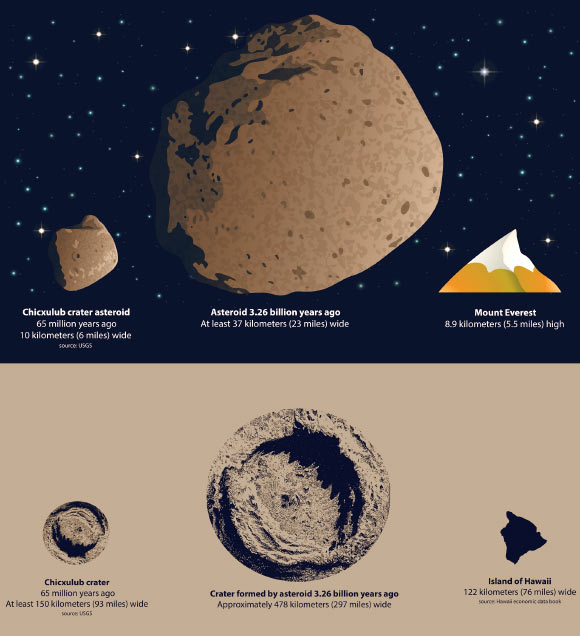A huge asteroid, up to five times larger than the rock thought to have wiped out the dinosaurs, crashed into Earth more than 3 billion years ago, say researchers Dr Norman Sleep and Dr Donald Lowe from Stanford University.

A graphical representation of the size of the dinosaur-killing Chicxulub asteroid, and the crater it created, compared to an asteroid thought to have hit the Earth 3.26 billion years ago and the size of the crater it may have generated. Image credit: American Geophysical Union.
Their study, published in the journal Geochemistry, Geophysics, Geosystems, reveals the power and scale of a cataclysmic event which is thought to have created geological features found in a South African region known as the Barberton greenstone belt.
The Barberton greenstone belt is an area 100 km long and 60 km wide that sits east of Johannesburg near the border with Swaziland. It contains some of the oldest rocks on the planet.
The findings show that the giant asteroid – between 37 and 58 km wide – collided with Earth at 20 km per second.
The jolt, bigger than a 10.8 magnitude earthquake, propelled seismic waves hundreds of km through our planet, breaking rocks and setting off other large earthquakes. Tsunamis thousands of meters deep – far bigger than recent tsunamis generated by earthquakes — swept across the oceans that covered most of the Earth at that time.
“We knew it was big, but we didn’t know how big,” Dr Lowe said.
The study models for the first time how big the asteroid was and the effect it had on the planet. It marks the first time scientists have mapped in this way an impact that occurred more than 3 billion years ago.
The impact would have been catastrophic to the surface environment. The smaller, dinosaur-killing Chicxulub impact is estimated to have released more than a billion times more energy than the bombs that destroyed Hiroshima and Nagasaki. The more ancient hit now coming to light would have released much more energy.
The sky would have become red hot, the atmosphere would have been filled with dust and the tops of oceans would have boiled.
The impact sent vaporized rock into the atmosphere, which encircled the globe and condensed into liquid droplets before solidifying and falling to the surface.
It may have been one of dozens of huge asteroids that scientists think hit the Earth during the tail end of the Late Heavy Bombardment period, a major period of impacts that occurred early in the Earth’s history – around 3 billion to 4 billion years ago.
Many of the sites where these asteroids landed were destroyed by erosion, movement of the Earth’s crust and other forces as the Earth evolved, but geologists have found a handful of areas in South Africa, and Western Australia that still harbor evidence of these impacts that occurred between 3.23 billion and 3.47 billion years ago.
Dr Sleep and Dr Lowe think the asteroid hit the Earth thousands of km away from the Barberton Greenstone Belt, although they can’t pinpoint the exact location.
“We can’t go to the impact sites. In order to better understand how big it was and its effect we need studies like this,” Dr Lowe explained.
The findings have important implications for understanding the early Earth and how the planet formed.
______
Norman H. Sleep & Donald R. Lowe. Physics of crustal fracturing and chert dike formation triggered by asteroid impact, ~3.26 Ga, Barberton greenstone belt, South Africa. Geochemistry, Geophysics, Geosystems, published online March 03, 2014; doi: 10.1002/2014GC005229







